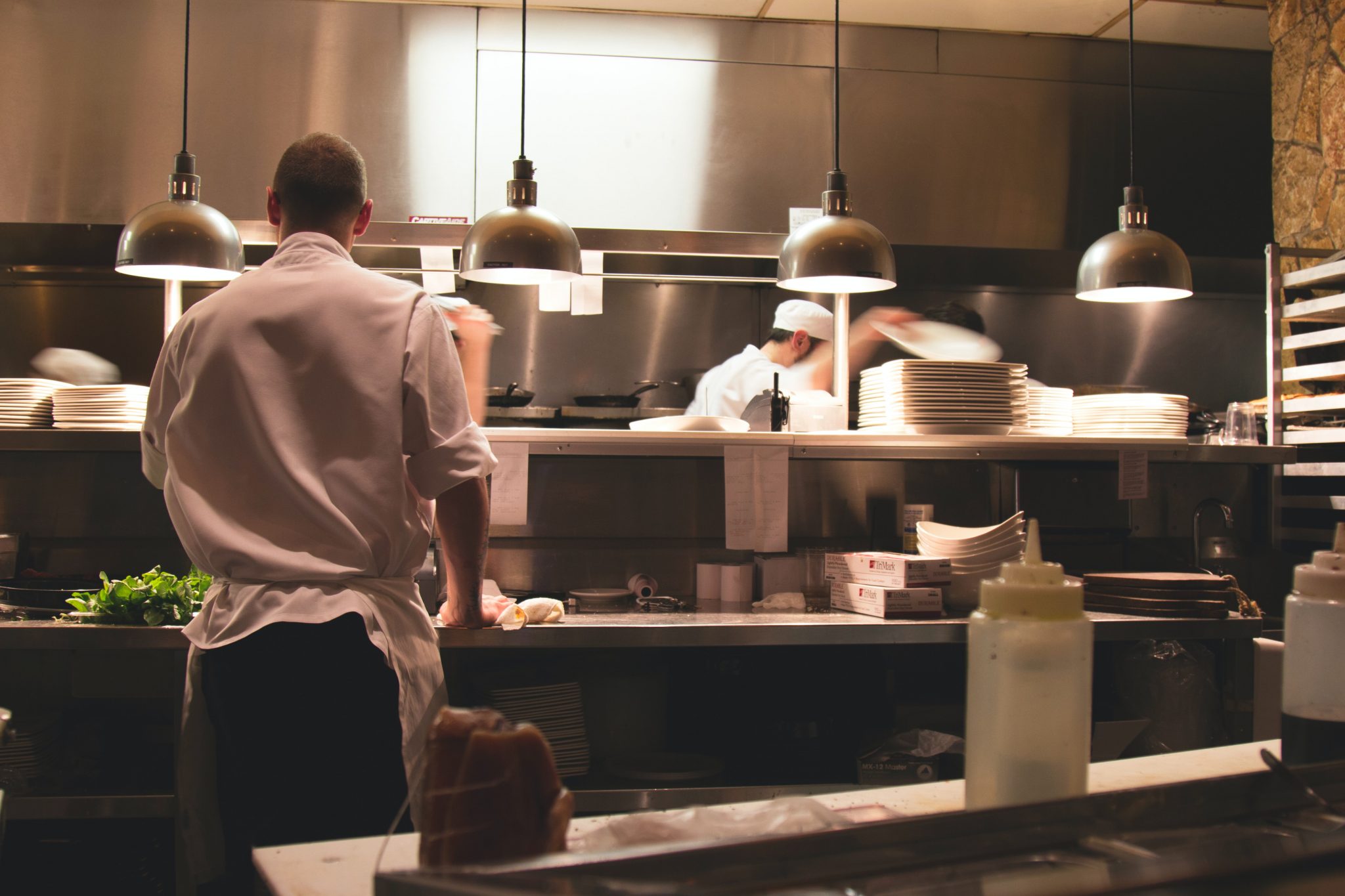
September 13, 2021 By Claudia Chiappa
Kate Papaleoni was terrified the catering company she’d spent years building was in danger. She founded Kate’s Table with her sister Kelly Griffin in 2013. They grew it together for years, earning Boston Magazine’s Best of Boston in 2019. Then, 2020 came and the pandemic hit.
Papaleoni said she watched as the pandemic “decimated the food industry as a whole,” forcing business owners to lay off staff, limit services, and in some cases, close down completely. For Papaleoni, one prominent thought in her head: can Kate’s Table survive?
“It was unprecedented, it was scary,” said Papaleoni. “We were among those saying ‘I hope we make it through.”
They did make it through, but recovery has not been easy. Kate’s Table, received nearly ¾ of a million dollars in federal aid from the Restaurant Revitalization Fund (RRF) last June. The fund was established by the American Rescue Plan Act to provide financial assistance to restaurants and eligible businesses all over the United States. Ten Hingham restaurants got aid, but industry advocates say the fund isn’t going far enough and are pushing Congress to put more money into the RFF for struggling restaurants.
An online survey of 1,000 U.S. adults shows six in 10 people have changed their dining habits because of concerns over rising Delta cases. Nine percent of adults have canceled already existing dinner plans in recent weeks. The survey also notes that one in three adults claimed they would be less likely to dine out if masks were required indoors.
In a letter to Congress, Sean Kennedy, with the National Restaurant Association writes, “A majority of consumers have changed their dining behavior in a manner that is beginning to put acute pressure back on the restaurant industry. This development comes on top of food and labor costs that are increasing at their fastest pace in several years, continued indoor capacity limits in 11 states, and crushing long-term debt loads for countless restaurant owners.”
The letter urges Congress to provide aid in particular to the 177,000 restaurants whose applications for RRF are still pending.
“The rise of coronavirus variants like delta threatens to push these restaurants closer to permanent closure,” reads the letter. “The small gains that our industry has made toward financial security are in danger of being wiped out, dashing the hopes of communities, entrepreneurs, and consumers nationwide.”
Local Funding:
In the first round of funding, 10 Hingham restaurants received funding, for a total of over $2 million. Massachusetts businesses received over $992 million in aid, one of the highest values compared to other states in the country.
Catering companies, like Kate’s Table, received a substantial amount of financial support from the RFF and Papaleoni said this might be due to the nature of the business.
“A lot of caterers aren’t prepared to do takeout and are not in the best locations to do it,” said Papaleoni.
Papaleoni received over $700,000 in aid, money which she said helped her get the business back on track and recover from ulterior losses.
“It was a really scary time,” said Papaleoni. “We put everything we had into this company, it was not only the source of my sister and I’s livelihoods, families. I'm also-we’re extremely close to the full time staff, and even part time staff. We felt very responsible for everybody's livelihood.”
Papaleoni said they were able to keep the business open for the first few months of the pandemic, offering curbside delivery and contactless delivery. This allowed them to continue operating under the extraneous circumstances until November, when Papaleoni said it had become clear that this system was not sustainable, and the company closed for the first time.
Will Zhao, owner of the Menchie’s Frozen Yogurt in Hingham and receiver of $169,089 from the latest round of RRF, said his business went through something similar. In 2020, Menchie’s was forced to close temporarily for two months. Its partial reopening in May only offered takeout and delivery, which meant about 30% of the usual sales according to Zhao.
Glimmer Of Hope:
The summer of 2020 allowed the business to partially reopen, while in May 2021 Menchie’s was back to its regular business. Kate’s Table fully reopened in April 2021. This was around the time most of the country started rolling back regulations and reopening. It was, to many, the end of a yearlong nightmare, the return to a yearned normality. And people’s joy was reflected in the parties and celebrations they threw.
“There is a sheer joy and happiness to that,” said Papaleoni. “That’s the nature of our business. People want to be able to gather and celebrate important life events.”
Regular service did not however mean regular profit. Despite the lifting of restrictions and mask mandates, businesses still struggled to return to their pre-pandemic profit. Zhao said current sales are about 80% of the store’s 2019 sales. Papaleoni also said the business is currently running a bit of a loss.
“There’s a lot of people that haven’t gone back to work yet,” said Papaleoni. “Especially in a business where you’re so forefacing with your clients, people are scared to be back out there.”
On top of the uncertainty and fear among the clientele, businesses had to face new challenges in the post-pandemic world. One of them is a substantial increase in supply and operational costs.
“Everything is increasing: the yogurt, toppings, all the essentials,” said Zhao. “Gloves are three times (the price) of before.”
Steve Clark, Director of Government Affairs at the Massachusetts Restaurant Association, said that it’s a matter of supply and demand.
“The cost of doing business has gone up,” said Clark. “The entirety of the restaurant industry feels the pandemic and also is probably the face of the recovery of the pandemic at the same time.”
The simultaneous reopening of thousands of businesses across the state also meant a sudden demand in employees. Despite this, many are still hesitant to work in businesses with such close contact with clients.
“The workforce challenges are being felt across all industries, and that’s causing some of the supply issues as well, which is driving the cost of supplies to go up,” said Clark.
Slow Recovery
The Restaurant Revitalization Fund helped Kate’s Table and Menchie’s recover from the previous year. Most of the money was dedicated to repaying debt and breaking even, said Papaleoni.
“That fund allowed us to get back on our feet without going into more debt,” said Papaleoni.
Similarly to Papaleoni’s experience, Zhao said he is using most of the money received from the fund to keep the business running and pay off debt.
“Without that fund, I don’t know how many small businesses can really survive,” said Zhao. “We’re trying to save every penny, cause we don’t know what happens tomorrow.”
Other Hingham businesses receiving money from the Restaurant Revitalization Fund include The Square Cafe, with the second largest amount in Hingham of almost $400,000, Raffael’s with nearly $320-thousand, Jolley Cafe (DBA, Sadie Mae’s Cupcakes) with more than $250-thousand, Smokey Stax BBQ with nearly $170-thousand, Gelato & Chill with over $140-thousand, Ocean Kai with approximately $110-thousand, and Matick Enterprises, Inc. and Vida Mexicana with over $20-thousand each.
While the RRF provided substantial financial relief for many businesses, several others saw their applications denied. Out of the 6,867 applications sent in from Massachusetts businesses, only 2,556 were approved. This led to an uneven advantage, said Clark.
“Certain restaurants have received fundings and others have not,” said Clark. “And they’re competing in the same town, they’re operating in the same Commonwealth, so we absolutely need more money to go into that fund.”
Even for the restaurants that started to get back on their feet over summer, the future looks uncertain. The celebration that came with the country’s reopening over the summer was short lived, as COVID-19 cases are spiking again with the Delta variant.
In the month of September Massachusetts already registered over 2,000 new COVID cases in a single day, a number the state had not met since April 2021. The Town of Hingham registered a total of 50 new COVID-19 cases reported in the two weeks prior to August 26, a stark uptick compared to the 29 cases registered in the two weeks prior to the August 12 report.
The latest surge in infections is predominantly caused by the spread of the Delta variant, which was found to be more aggressive and contagious than the previous straints.
“It seems like we’re in a recurring nightmare,” said Clark. “I thought we were on the end of it. But we continue to be in this spin cycle of negativity and trying to recover from this pandemic.”
Cases had plummeted earlier in the summer, and the state had lifted all restrictions in May. it seemed as if normalcy had returned to Massachusetts, but numbers started to rise again in July. the public fears another lockdown, as some towns begin to rethink their latest lax policies. The City of Boston reinstated its indoor mask mandate on August 27.
“A lockdown would be disastrous for the industry, it would be demoralizing to the industry, it would be demoralizing to the employees, it would be demoralizing to the customers,” said Clark. “We can’t go back.”
Kate Papaleoni agrees. “After what we’ve been through, it’s very scary,” she said


